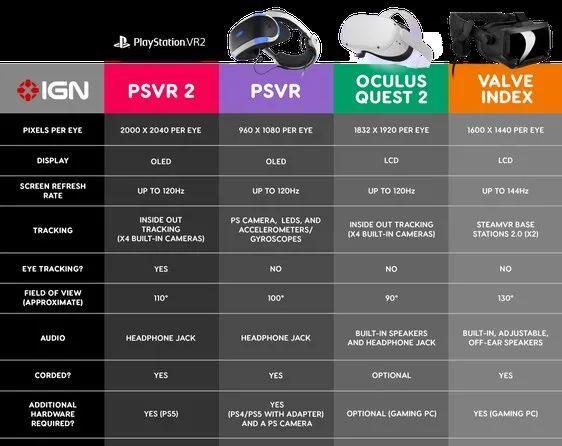*This article is compiled from IGN US and is not reproduced without authorization.
At the SONY launch of CES 2022, we finally learned more details about the second generation of PSVR (hereinafter referred to as PSVR 2).
The pricing, release date, and even what exactly it will look like is still unknown, but Sony has revealed a lot of information on parameters that gives us a glimpse into the "core" of this next-generation VR headset.
To better understand what we expect from PSVR 2, we started with the parameters and dug deep into some of the standard features before comparing it to the Oculus Quest 2, Valve Index, and the original PSVR.
Resolution with screen

The parameters of PSVR 2 and other peripherals are compared in the table above. Based on what we know about PSVR 2 now, in terms of monocular resolution and pixels, its closest opponent should be the Quest 2, and this headset will not have the best monocular resolution after its release. HTC's Vive Pro 2 remains the champion in this regard, with this 5K headset capable of delivering a monocular resolution of 2448x2448.
Like the previous generation of headsets, the PSVR 2 will bring a refresh rate of up to 120Hz and an OLED panel. Previously, we discussed the difference between LCD panels and OLED panels when comparing the new and old NS, and the biggest difference is the way the two panels are lit.
LCD panels use backlighting to continuously illuminate the screen, while OLED panels illuminate each pixel alone and light up when there is a picture; LCD screens are usually brighter, but OLED screens can bring better contrast and purer black. Since we're now talking about VR headsets instead of traditional monitors like TVs, we just need to know a few things.
Analyst Ross Young pointed out in a recent article about Apple's VR/AR headset that VR headsets rarely use OLED panels because OLED panels are less pixel dense than LCD panels commonly used in headsets, which usually leads to low image quality. Young also said that high-pixel density OLED panels are achievable, but the cost is also higher. We don't know more details about the PSVR 2 panel at the moment, but it's certainly OLED.
Tracking technology
The PSVR 2 uses integrated head tracking, which is a big improvement over the first generation of PSVR that requires PS cameras, LED lights and other devices to track the action. Similar to quest 2, PSVR 2 has 4 built-in cameras that track the controller and player's movements.
First PlayStation VR
However, the PSVR 2 adds a new and exclusive feature that doesn't even have Meta's flagship VR headset – Eye Tracking, which allows Sony's future flagship VR headset to detect eye movements. It's mentioned in their journal that this means that a whole new input is added when your eyes are looking in different directions, allowing PSVR 2's gameplay to add more immersion to the design.
Rumor has it that Valve is working on another VR headset, which may also have eye tracking, meaning that this feature may not only be unique to PSVR 2 games, but also allow more developers to design games around it.
controller
The controller of the PSVR 2 is the highlight of this device. Similar to the PS5's DualSense handle, the controller is called the PSVR 2 Sense Controller, and both handles come with vibration feedback and an adaptive trigger, a big step forward in the original PSVR.
Vibration feedback and adaptive trigger in sense Controller combined with the shock support of the headset allow the PSVR 2 to deliver an immersion that was unmatched by previous-generation headsets and even other VR devices. They introduce in the journal that new sensing features added by headsets and controllers allow players to "get closer to the gameplay experience," such as feeling the character's accelerating pulse during tense moments.
Additional hardware requirements
The PSVR 2 is designed for the PS5, so this headset, like the original PSVR, must be connected to a host computer to use. Consistent with the current high-end VR headsets on PCs such as valve index and HTC Vive Pro 2, they also require a VR-enabled PC and a base station sensor for companion tracking to work properly.
In stark contrast is Meta's hugely popular Oculus Quest 2, an all-in-one headset that requires no additional hardware to play and can also play SteamVR games when connected to a PC.
While the PSVR 2 is bound to game consoles, Sony simplifies the wire needed for this next-generation VR headset. The PSVR 2 will use a single cable to connect to the PS5, and its built-in camera also means no additional sensors are required. This design is much simpler than the original generation of PSVR, which requires more cables plus a PS camera and a processing box to make the game space a mess.
The PSVR 2 has not yet announced its release date, and the price has only left a big question mark. Hopefully, Sony will share more information about the PSVR 2 with us next. In the meantime, you can check out the first game released by PSVR 2, Horizon Call of the Mountain.